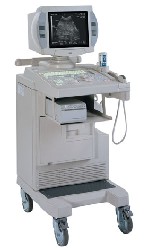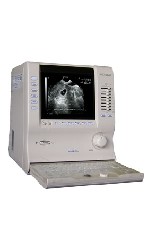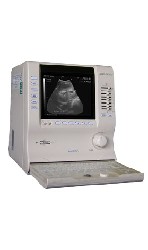Medical Ultrasound Imaging
Saturday, 27 April 2024
'Image Quality' Searchterm 'Image Quality' found in 40 articles 1 term [ • ] - 39 definitions [• ] Result Pages : • Image Quality
The perfect image quality is dependent on some assumptions of the propagation of ultrasound waves in tissues after generating in an imaging system. These assumptions are important for the developing of optimal ultrasound imaging systems.
•
The propagation of ultrasound is straight ahead.
•
•
•
•
The amplitudes of the echoes are proportional to the difference of the acoustical impedance caused by different tissue layers.
See also Coded Excitation, Validation and Refraction Artifact, Q-Value, Ultrasound Phantom, Dead Zone, Narrow Bandwidth. Further Reading: News & More: •
Ultrasound technology has evolved significantly, providing sonographers with a wide range of ultrasound machines. As technology has advanced, portable ultrasound equipment, including handheld ultrasound systems, have emerged in the field of medical imaging. However, these devices may have limited imaging capabilities and reduced image quality compared to larger systems. Types of ultrasound systems compiled according to their portability: •
Handheld Ultrasound Devices: Handheld ultrasound devices are compact, lightweight, and easily maneuverable. They offer convenience and point-of-care imaging capabilities, making them ideal for emergency medicine, primary care, and remote settings. Pros include portability, rapid assessments, and ease of use. However, these devices may have limited imaging capabilities and reduced image quality compared to larger systems. •
Laptop-Based Ultrasound Scanner: Laptop-based ultrasound machines combine portability with a larger display and enhanced imaging capabilities. They are versatile and suitable for various applications, including primary care, obstetrics, and musculoskeletal imaging. These machines provide good image quality, a user-friendly interface, and improved storage capacity. However, they may still be bulkier and less portable than handheld devices. •
Console-Based Ultrasound Systems:
Console-based ultrasound machines are larger, stationary systems commonly found in hospitals and specialized imaging centers. They offer comprehensive imaging capabilities, advanced features, and excellent image quality. These machines are suitable for a wide range of specialties and can perform complex examinations. Pros include high image resolution, advanced imaging modes, and comprehensive data management. However, they lack the portability and immediate accessibility of handheld or laptop-based devices.
•
Cart-Based Ultrasound Machines: Cart-based ultrasound machines strike a balance between portability and advanced imaging capabilities. They consist of a console unit mounted on a mobile cart. These machines are commonly used in hospitals, clinics, and larger healthcare facilities. They provide excellent image quality, a wide range of imaging options, and ergonomic considerations. While less portable than handheld or laptop-based devices, cart-based machines offer enhanced functionality and versatility. In summary, pros and cons of portable ultrasound machines: •
Pros: Compact portable ultrasound machines eliminate transfers and reduce wait times, improving patient comfort. Scans at the bedside minimize discomfort and anxiety while optimizing workflow efficiency. Sonographers can quickly assess patients and detect abnormalities. Real-time examinations provide immediate visualization, procedural guidance, and support for critical decision-making especially in emergency, critical care, and resource-limited settings. •
Cons: Portable ultrasound machines may have restricted features and imaging modes compared to larger systems, potentially affecting diagnostic quality and detail. The compact size can lead to compromises in image resolution and overall quality due to factors like lower power output and smaller transducers.The small displays and simplified controls of portable systems may pose challenges for sonographers, potentially impacting workflow efficiency and user fatigue. Portable ultrasound machines often come with a higher price tag, requiring careful evaluation of cost versus expected benefits and specific practice needs. See also Ultrasound Accessories and Supplies, Environmental Protection, Sonographer, Ultrasound Technology and Equipment Preparation. Further Reading: News & More:
•  From ALOKA Co., Ltd.;
From ALOKA Co., Ltd.;'Unsurpassed Image Quality and Performance The SSD-1400 offers the highest image quality and performance among our line of gray-scale imaging units.' •  From ALOKA Co., Ltd.;
From ALOKA Co., Ltd.;'Innovative Image Quality in a Compact Size. Featuring design concepts inherited from our higher end systems along with Aloka's latest proprietary electronic technologies, the compact SSD-900 delivers superb images. Traditionally, portable units suffer from hardware and software limitations that affect image quality. Aloka's SSD-900 sets new standards for what's possible in a portable unit. Incorporating over 50 years of experience and unique micro-chip technologies, the SSD-900 generates incredibly high-resolution images. The SSD-900 offers a full range of measurement functions for professional ultrasonic examination. And unlike conventional portable systems, the SSD-900 includes annotation labeling and 15-channel preset functions as standard features. The system also use Super High Density transducers (found our high-end systems) to enhance imaging resolution. These multi-frequency transducers provide a broad range of imaging frequencies to optimize scan frequency for depth of view.' •  From ALOKA Co., Ltd.;
From ALOKA Co., Ltd.;'Innovative Image Quality in a Compact Size Featuring design concepts inherited from our higher end systems along with Aloka's latest proprietary electronic technologies, the compact SSD-900V delivers superb images. Traditionally, portable units suffer from hardware and software limitations that affect image quality. Aloka's SSD-900V sets new standards for what's possible in a portable unit. Incorporating over 50 years of experience and unique micro-chip technologies, the SSD-900V generates incredibly high-resolution images. The SSD-900V offers a full range of measurement functions for professional ultrasonic examination. And unlike conventional portable systems, the SSD-900V includes annotation labeling and 15-channel preset functions as standard features. The system also use Super High Density transducers (found our high-end systems) to enhance imaging resolution. These multi-frequency transducers provide a broad range of imaging frequencies to optimize scan frequency for depth of view.' Result Pages : |
Medical-Ultrasound-Imaging.com
former US-TIP.com
Member of SoftWays' Medical Imaging Group - MR-TIP • Radiology TIP • Medical-Ultrasound-Imaging
Copyright © 2008 - 2024 SoftWays. All rights reserved.
Terms of Use | Privacy Policy | Advertise With Us
former US-TIP.com
Member of SoftWays' Medical Imaging Group - MR-TIP • Radiology TIP • Medical-Ultrasound-Imaging
Copyright © 2008 - 2024 SoftWays. All rights reserved.
Terms of Use | Privacy Policy | Advertise With Us
[last update: 2023-11-06 01:42:00]




